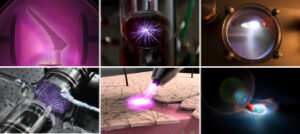Leadership
- Prof. Dr. Ronny Brandenburg, Leibniz Institute for Plasma Science and Technology (INP), Greifswald / University of Rostock
- Prof. Dr. Dirk Uhrlandt, Leibniz Institute for Plasma Science and Technology (INP), Greifswald / University of Rostock
- Prof. Dr. Achim von Keudell, Ruhr-University Bochum
The domain Physics of Plasma is represented in the consortium by the field of low-temperature plasma physics. The term plasma is used to describe a gaseous state in which free electrons and ionized atoms exist. The gas temperature of low-temperature (“cold”) plasmas varies in the range from room temperature to several thousands of Kelvin. Low-temperature plasmas form the basis for plasma technology as a cross-sectional technology present in a large variety of applications. To give examples, plasma surface processes are a key technology in microelectronics fabrication and have a great potential for new nano-structured materials e.g. for future batteries, solar cells and fuel cells. Arc welding and furnace, plasma cutting, spraying and hardening as well as many different coating processes are examples for established manufacturing processes. A speciality of “cold plasmas” is to be applicable on sensitive surfaces and on human skin which has opened recently new application areas like plasma medicine, decontamination, food processing and plasma agriculture.
 Fundamental research in low-temperature plasma physics as well as applied research in plasma technology is in a wide range characterized by small-scale table-top experiments. In these experiments not only the processes in the plasma but the manifold interactions with gaseous, liquid and solid surroundings are studied, in particular the interaction with substrates, walls and electrodes. The huge variety of plasma sources and technical options on one hand and the manifold of applications on the other hand lead to the situation that setups in the different research groups are unique in almost all cases. In analogy to the laboratory experiments, a plasma source operating in and interacting with a medium as well as with surroundings and substrates is considered in most of numerical simulations in relation to plasma technology applications. And similar to the situation in the labs there are no standards for storage and documentation of computational data. Therefore, scientific results can hardly be compared and validated on a quantitative level among the groups without an almost complete documentation of the setup including the diagnostic tools and simulation method, respectively. Documentation and file standards are urgently required to achieve a certain data quality and facilitate the exchange and validation of data.
Fundamental research in low-temperature plasma physics as well as applied research in plasma technology is in a wide range characterized by small-scale table-top experiments. In these experiments not only the processes in the plasma but the manifold interactions with gaseous, liquid and solid surroundings are studied, in particular the interaction with substrates, walls and electrodes. The huge variety of plasma sources and technical options on one hand and the manifold of applications on the other hand lead to the situation that setups in the different research groups are unique in almost all cases. In analogy to the laboratory experiments, a plasma source operating in and interacting with a medium as well as with surroundings and substrates is considered in most of numerical simulations in relation to plasma technology applications. And similar to the situation in the labs there are no standards for storage and documentation of computational data. Therefore, scientific results can hardly be compared and validated on a quantitative level among the groups without an almost complete documentation of the setup including the diagnostic tools and simulation method, respectively. Documentation and file standards are urgently required to achieve a certain data quality and facilitate the exchange and validation of data.
Use cases
- Plasma01 Dr. Dirk Uhrlandt, Prof. Dr. Ronny Brandenburg, Dr. Marcus Becker
- Plasma02 Prof. Dr. Achim von Keudell, Dr. Marina Prenzel
- Plasma03 Alexander Kessler
previous domain (Optics and Photonics) | domain list | next domain (Biological Physics)